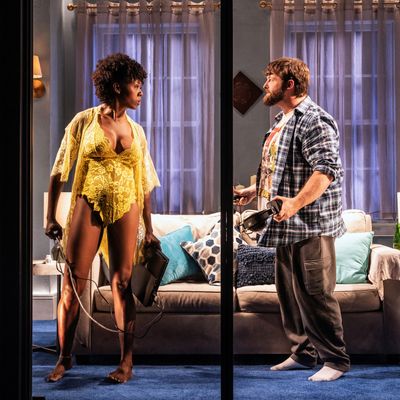
As live, in-person production continues to gather steam, performance is teetering on a weird threshold. Many audience members are vaccinated and ready to get in a theater (which they can do!), but the form is still caught halfway between the stringency of shutdown and the growing ease of opening up. It takes a long time to make a show: If you go to a play now, youÔÇÖre watching something built at least six weeks ago, obeying restrictions that are constantly shifting. When we watch these productions, weÔÇÖre looking backward into a slightly more contact-averse time. The corner restaurant will be doing brisk 100 percent business, but at the theater, you might be in a Mission: Impossible clean room, with the actors calling in from another country altogether.
The lushly made Seven Deadly Sins  first produced in Miami in December  does therefore sometimes feel slightly  anesthetized. Tectonic Theater Project and Madison Wells Lives show is impressively mounted and designed, handsomely transplanted from Miami Beach to the Meatpacking District and its expensive cobblestones. For all its gorgeosity, though, its still an oddly thin experience.
The concept is clever and simple: Seven playwrights write seven sin-themed plays, which appear in seven actual store-window displays. The audience, broken into small groups, follows a guide along the storefronts, listening to each play through provided headphones. (We sit shoulder to shoulder, but the actors are sealed away behind a pane of glass.) Director Mois├®s Kaufman and designer David Rockwell give each tableau a beautiful microenvironment, but this only exaggerates the feeling that we are visiting R-rated BloomingdaleÔÇÖs Christmas displays. The short theater pieces sometimes ask us to deeply engage ÔÇö Ming PeifferÔÇÖs Longhorn takes on the wrath of bigots murdering Asian women, for example ÔÇö but the environment has shifted our minds into an unserious window-shopping mode. You canÔÇÖt feel deeply and browse at the same time.
Still, so much is impressive here. ThereÔÇÖs certainly productive weirdness in our private theatrical experience happening in public. The showÔÇÖs introduction takes place in ÔÇ£PurgatoryÔÇØ (a little platform across the street from the Whitney), and consists of the RuPaulÔÇÖs Drag Race star Shuga Cain stripping off a sparkly cassock and bishopÔÇÖs miter while lip-syncing ÔÇ£I Feel a Sin CominÔÇÖ On.ÔÇØ This would normally be a raucous experience, but the audience sits silently in the middle of Gansevoort Street, listening to everything on headphones. Watching Shuga Cain was a delight, but watching us must have been a trip. Imagine being a bystander: Shuga Cain winks and beckons and mouths the lyrics, but the only sound is the wind. It was very A Quiet Place Goes to the Barracuda Bar.
We are assured that weÔÇÖre in for a night of total wildness and debauchery (this does not turn out to be the case), and then three guides lead us to the playlets. This, of course, is where the rubber ÔÇö and the leather ÔÇö needs to hit the road. Unfortunately, the ten-minute-play form is exacting. A writerÔÇÖs idea needs to be so efficient, her execution so precise, that she can swiftly grab a watcher in her undertow. The uneven results are not a judgment on any of the writers involved, many of whom are dazzling playwrights. ItÔÇÖs just that the form fights them.
Of the seven, only two truly find their feet ÔÇö the tremendous Lust, by Bess Wohl, and KaufmanÔÇÖs own Watch, a tidy little greed-themed scene with a nice comic button. In Watch, two siblings (Tricia Alexandro and Eric Ulloa) snipe over their fatherÔÇÖs coffin, multitasking by mourning, greeting family members, and bickering over what theyÔÇÖre owed. ItÔÇÖs beautifully measured, as satisfying to look at as a perfectly packed suitcase. Will I remember it in a year? Unlikely ÔÇö but technical confidence creates its own pleasures. Lust, on the other hand, manages to be both beautiful and unforgettable. Wohl precisely exploits the peep-show aesthetic: We watch the superbly graceful Donna Carnow, in towering heels and a tiny bikini, pole-dance in the window. She doesnÔÇÖt speak; instead, we hear Cynthia Nixon voicing CarnowÔÇÖs thoughts ÔÇö first her grocery list, then a turbulent stream-of-consciousness panic as she spots a threat in the audience. The police wonÔÇÖt help her, she knows, the male world is against her. Her body undulates like a ribbon in water. ÔÇ£All I have is my moves,ÔÇØ she thinks, her corded muscles turning vulnerable as we watch.
There was also, of course, another show happening all around us. As much as our guides tried to amp up our feelings of transgression (ÔÇ£Yaaaass queenÔÇØ uttered perhaps too many times), there was no hiding that we were obedient ducklings following them about, a kindergarten class on a field trip. Yet we were in the Meatpacking District during Pride. As we walked to our relatively square little entertainments, we passed outrageous, sweaty, peacock creatures wearing the true plumage of public display. Our peep shows were so tame by comparison! So hermetically sealed! As we walked, our guide pointed out places that used to be sex clubs, famous hangouts, the dens of iniquity that gave New York her good name. TheyÔÇÖre all gone now, of course, although there is now an Herm├¿s store nearby. For all its naughty set-dressing, Seven Deadly Sins belongs more to this $25 burger version of the city than the world of the Mineshaft and Florent. ThatÔÇÖs not a sin, exactly ÔÇö but itÔÇÖs sure as hell not a virtue.


